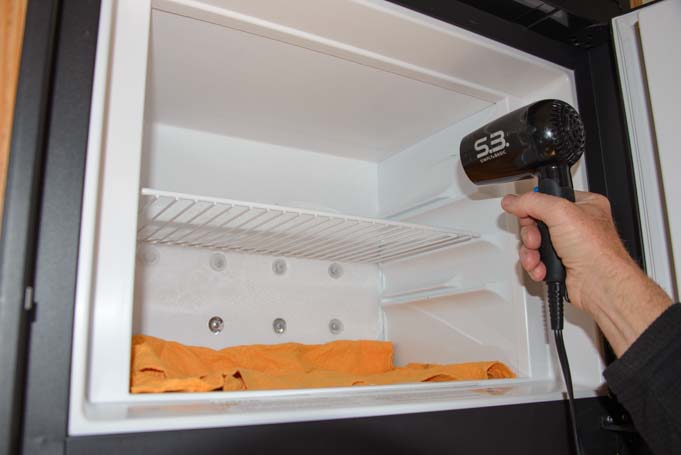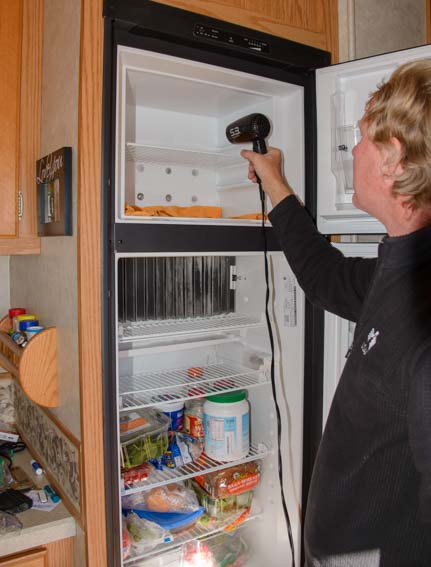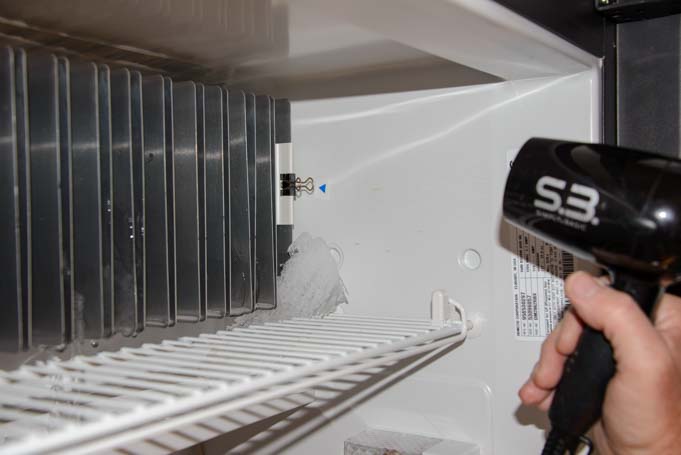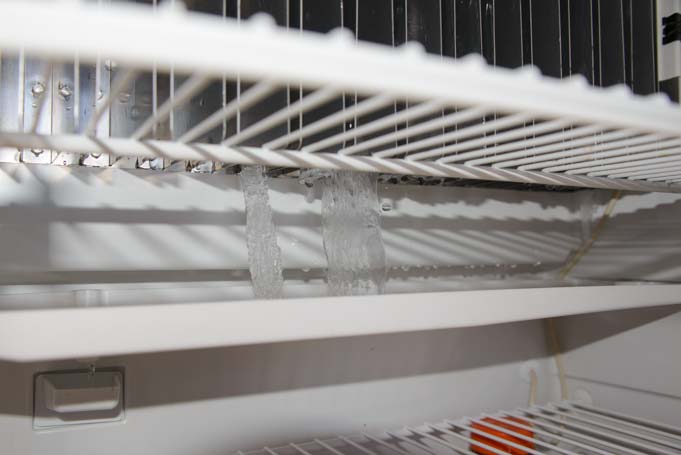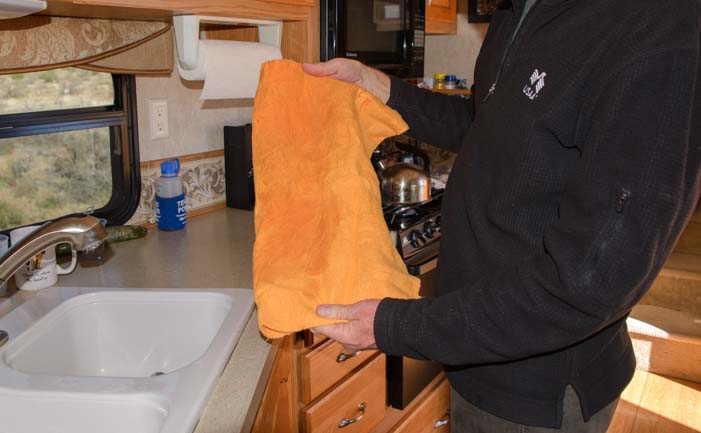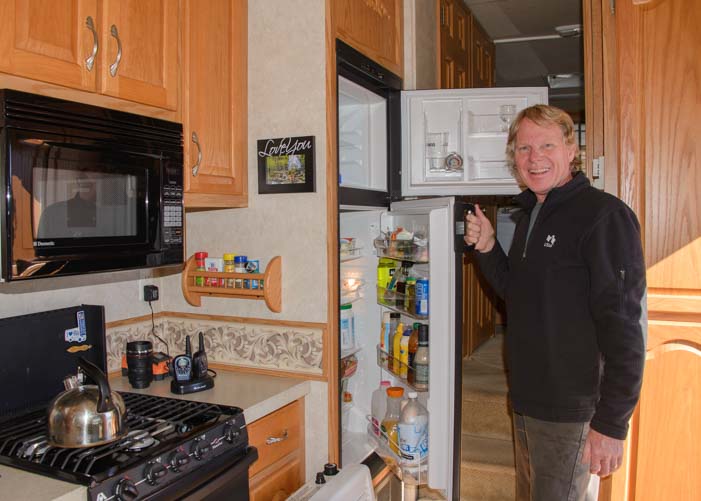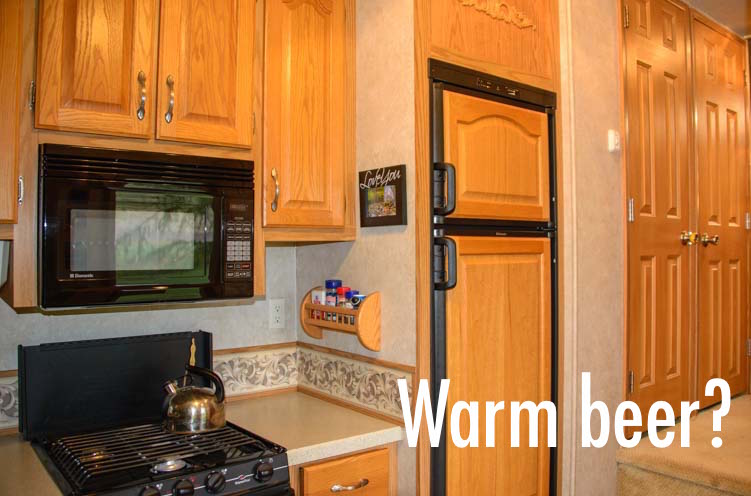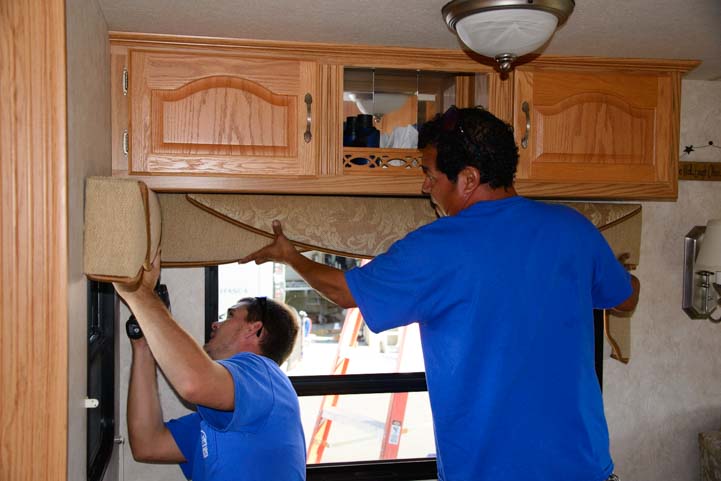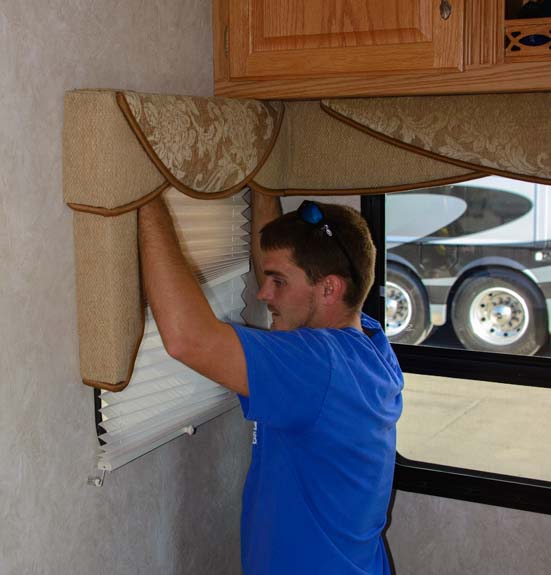June 2019 – One of the biggest surprises for us when we began our search for a new fifth wheel RV to be our full-time home was the gargantuan sizes of modern day RV refrigerators. When we last searched for a full-time fifth wheel in 2007-08, most upscale rigs had a modest 10 cubic foot refrigerator in the base model.
In those days, many of the manufacturers of higher quality rigs offered an upgrade to a 12 or 14 cubic foot fridge. Also, a lot of the entry level units being built back then by those same (now non-existent) manufacturers had an 8 cubic foot fridge with an upgrade to a 10 footer available.
Our Hitchhiker was a “budget” model that we bought right off the back lot at the factory, so we ended up with the smaller 8 cubic foot fridge.

Our 2007 Hitchhiker fifth wheel has an 8 cubic foot refrigerator. This now “tiny” fridge has served us well since we moved into our trailer in 2008.
This was an upgrade for us anyway. Our first year of full-timing in 2007 was spent in a 27′ travel trailer that had a 6 cubic foot fridge. So, moving to a bigger fridge in 2008 was terrific.
The 8 cubic foot model has been fine for us ever since then, although our ears do sometimes perk up when we hear the turf wars breaking out between the veggies and the beer.
Neither the beer nor the veggies has emerged a consistent winner over the years, but we have found a way to keep the battles from spreading onto every shelf in the fridge.
Even though most owners of late model higher end RVs have either a residential 110 volt a/c refrigerator or an 18 cubic foot two-way “RV refrigerator” that runs on either propane or household 110v electricity, modest sized RV fridges still appear in many smaller RVs and truck campers. So, I thought I’d share our tactic for keeping those big unwieldy bags of vegetables under control.

RV two-way propane/electric refrigerators do best when stuffed full.
There’s actually lots of room for goodies even in this small model.
This isn’t even full!
I like to buy all the veggies we’ll be eating for the next week or so at once and then cut them up and store them in a single container all together. I cut them in large chunks and then layer them into the container so they are nicely mixed rather than segregated.
I’ve found about six to nine veggies will fill a half-gallon size plastic tub. I have a taller thinner size container with a snap-on top that disappears inconspicuously into a corner of the fridge. I mix up the types of vegetables I put in it with each supermarket run.

All these colorful fresh veggies used to take up a lot of room in the fridge. Their plastic bags were everywhere!
Sure, this method means that we eat the same basic veggie mix until it’s all gone, but I love being able to grab the veggie bin and whip up something without having to take each individual vegetable out of the fridge, get it out of its plastic bag, and chop off what I need for that meal.
If I want the veggies diced smaller, I just grab the chunks I want from the bin and cut them into smaller pieces.

All those veggies fit in this small half-gallon snap-top container!
The veggies seem to last quite well in this snap-top tub, usually a week to ten days. Starting with super fresh veggies helps.
We have our own favorite vegetables, but depending on what is popular in your RV, any or all of these work well:
- Bell peppers (pretty colors)
- Zucchini and/or summer squash
- Broccoli and/or cauliflower
- Green beans
- Snap peas
- Baby carrots
- Grape tomatoes
- Celery
- Red onion

The veggie container is tucked away in a corner!
Things we do with them (sometimes diced smaller) have included:
- Served raw with a veggie dip made from plain yogurt and a ranch style powdered dressing mix
- Served on a bed of spinach and/or romaine lettuce as a salad
- Stir-fried in olive oil in a skillet
- Cooked in a covered, salted skillet on medium heat with a splash of water thrown in one minute before serving for quick steaming
- Steamed/boiled in a pot
- Lined up on a skewer and grilled on our BBQ grill (best if segregated due to different cooking times)
- Tossed into an omelet with meat and cheese
- Rolled into a tortilla and microwaved with leftover steak/burgers/chicken topped with a little cheese

There are lots of ways to make veggies yummy.
I’ve managed quite a few small refrigerators over the years as I’ve lived on various sailboats and in RVs.
For sailors who come across this article, the best way I found to deal with the big, deep, dark refrigerators on older boats that require a veritable deep dive — feet in the air — to be able to reach the bottom is to put everything in large tupperware containers, segregating the meat, veggies, cheeses and even the condiments. This way, it’s easy to find the items you want because you are handling only a few big containers that are well labeled rather than digging around for that small jar of mustard you know is buried at the bottom in the wet mess somewhere.
Likewise with the tiny 3.5 cubic foot under-counter RV fridge that we had on our sailboat in Mexico. The plastic tubs were smaller and didn’t have covers (so the contents could mound up above the sides a bit as necessary), but the important items were grouped together into two or three bins, and when mealtime prep began, all the bins were taken out of the fridge at once and laid out so it was easy to locate the individual bits and pieces.
One of the unfortunate side effects of RV manufacturers moving towards ever larger refrigerators is that they cost a lot in terms of usable space in the kitchen. An 18 cubic foot RV refrigerator is 36″ wide while an 8 or 10 cubic foot RV refrigerator is only 24″ wide.
I measured out the 12″ we would have lost if our Hitchhiker fifth wheel had been built to accommodate an 18 cubic foot RV refrigerator the way all modern larger fifth wheels are built nowadays. We would have lost an important section of counter space, an upper cabinet that houses three shelves and a lower cabinet that contains a drawer and two shelves underneath. That is a lot of nicely partitioned storage to give up!

Modern higher end RVs have 18 cubic foot propane/electric refrigerators that eat up other kitchen counter and cabinet space.
RV refrigerators don’t get the Energy Star rating that many residential refrigerators do. They are inefficient and they operate best when they are packed to the gills with lots of cold stuff inside.
After we do a big shopping spree, we usually have two levels of goodies on every shelf and all the cold stuff is squeezed in pretty tight. As the days go on it loosens up a bit.
Given the RV propane refrigerator quirk of needing a very full fridge to operate well, I can’t imagine having enough cold food to keep an 18 cubic foot refrigerator continuously stuffed in a household with just two people. We would have to chill 24-packs of beer and multiple gallons of fresh water. Frankly, I think I’d be chilling our canned goods too!
That is all fine and dandy, but where space is at a premium — especially in the tiny living quarters of a toy hauler — it seems silly to give up precious cabinets and counter space to have a fridge that is difficult for two people to keep properly stocked (to overflowing) all the time.
Not only does it take a lot of propane to run an RV fridge when shorepower isn’t available, but RV refrigerators are expected to fail after about 8 years. We replaced our RV fridge under warranty right at the 8 year mark when it died unexpectedly.
An 18 cubic foot RV refrigerator costs somewhere around $4,000 whereas our little 8 cubic footer was just $1,500 or so in 2015. We didn’t have to pay out of pocket for it because we had an excellent RV extended warranty.
However, built into the cost of any extended RV warranty is the cost of replacing the major appliances, including the RV refrigerator. So, the price of an extended warranty for an RV with an 18 cubic foot RV refrigerator is going to be a whole lot more than the price of an extended warranty for an RV with an 8 cubic foot RV refrigerator.
The bottom line that isn’t so obvious on the RV showroom floor is that RVers get hit with the exorbitant cost of replacing a huge two-way propane/electric RV fridge either way. Wouldn’t it be awesome if RVers were given a choice on a $100k (or more) RV to have a more modest sized RV fridge?
Of course, an 18 cubic foot residential 110 volt refrigerator is a fraction of the cost of an equivalent propane/electric RV refrigerator, along the lines of $2,000 versus $4,000, but powering such a beast without shorepower is a big ol’ can of worms unto itself. This is likely the reason why the National Sales Director at one of the major mass market RV manufacturers told us “The industry is getting away from residential refrigerators and going with the new 18 cubic foot RV refrigerators instead.”
Ironically, requesting a 10 cubic foot RV refrigerator from the custom manufacturers was met with the head scratching concern that their units are built to a certain very high standard and a modest RV refrigerator is not really up to that standard. In the end, they would prefer not to have their name on a fifth wheel roaming around the country sporting a smaller RV fridge. Undoubtedly, that issue could be pressed, but our initial request was not met with the expected enthusiasm of, “Oh, of course we can do that. We’d be glad to!”
Now, these are all very personal preferences, and there’s no right or wrong way to live the RV lifestyle. Our RV search has been an interesting journey through the maze of the modern day fifth wheel market, and this crazy refrigerator issue has been just one odd stumbling block in the whole process.
I just finished writing a detailed article for Trailer Life magazine about what we’ve learned and seen in our search. The article will be appearing in the September 2019 issue. If you subscribe to Trailer Life, keep an eye out for it!
In the meantime, give the veggie pre-prep idea a try. I like handling our veggies this way so much that I’d probably do it no matter how big a fridge we had, whether in a rolling home or in a stick-built house!
Subscribe
Never miss a post — it’s free!
More blog posts about RV refrigerators:
- RV Refrigerator Management Tip – Winning the Turf Wars!
- How to Defrost an RV Refrigerator in 20 Minutes!
- RV Refrigerator Replacement – How an RV Warranty Saved Our Bacon!
More blog posts about choosing an RV:
- 2024 Alpha Wolf 17CB Trailer – Our Goldilocks RV!
- Toy Hauler Life – What’s It Like Living in a Toy Hauler?
- 2022 Genesis Supreme 28CRT Toy Hauler – Why We Chose It!
- Truck Camper Pros and Cons – The Good, The Bad and The Ugly!
- Truck Camper and Small RV Storage Tips!
- 2005 Arctic Fox 860 Truck Camper – Grand Tour!
- Finding a Fifth Wheel Trailer or Toy Hauler to be a Full-time Home!
- Triple Tow or Toy Hauler? How to RV Full-time with a RZR?
- Escapod Teardrop Trailers – Rugged Campers for Off-Road Adventure!
- What are the Most Important Features in a Full-time Fifth Wheel Trailer?!
- Choosing a Trailer for Full-time RVing: Cargo Carrying Capacity
- Go Cheap, Go Small, Go NOW!! Have Fun & LEARN in a Small RV
- Dodge Ram 3500 Dually Truck – Best RV Fifth Wheel Trailer Towing
- Going Full-time RVing: How to Transition & Which RV Is Best?
- Casita Travel Trailers – Lots of RV in a Tiny Package
- How big an RV do you need?
Our most recent posts:
- How to Install Starlink Gen 3 in an RV? Use the Speedmount! 08/07/25
- Escape to Paradise – Rocky Mountain Magic! 08/01/25
- Is Forest River a Good RV? Well Built? Here’s Our Experience 06/20/25
- Sunset Crater Nat’l Monument – Lava & Camels at Bonito CG! 06/06/25
- 2024 Alpha Wolf 17CB Trailer – Our Goldilocks RV! 04/25/25
More of our Latest Posts are in the MENU.
New to this site?
Visit RVers Start Here to find where we keep all the good stuff. Also check out our COOL NEW GEAR STORE!! *** CLICK HERE *** to see it!



